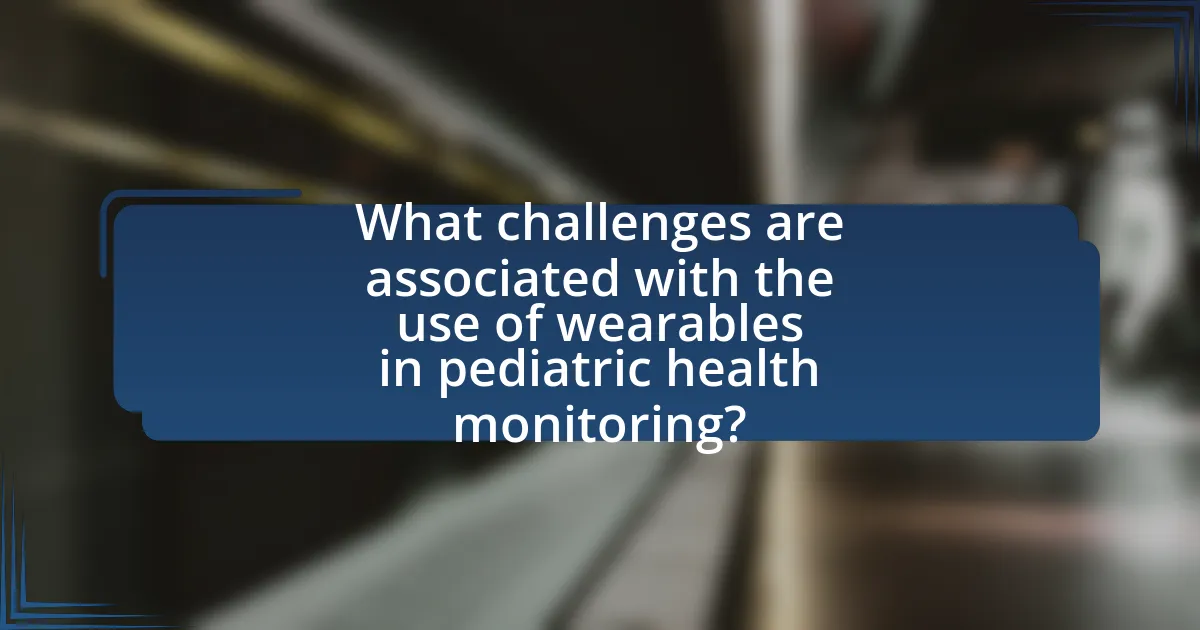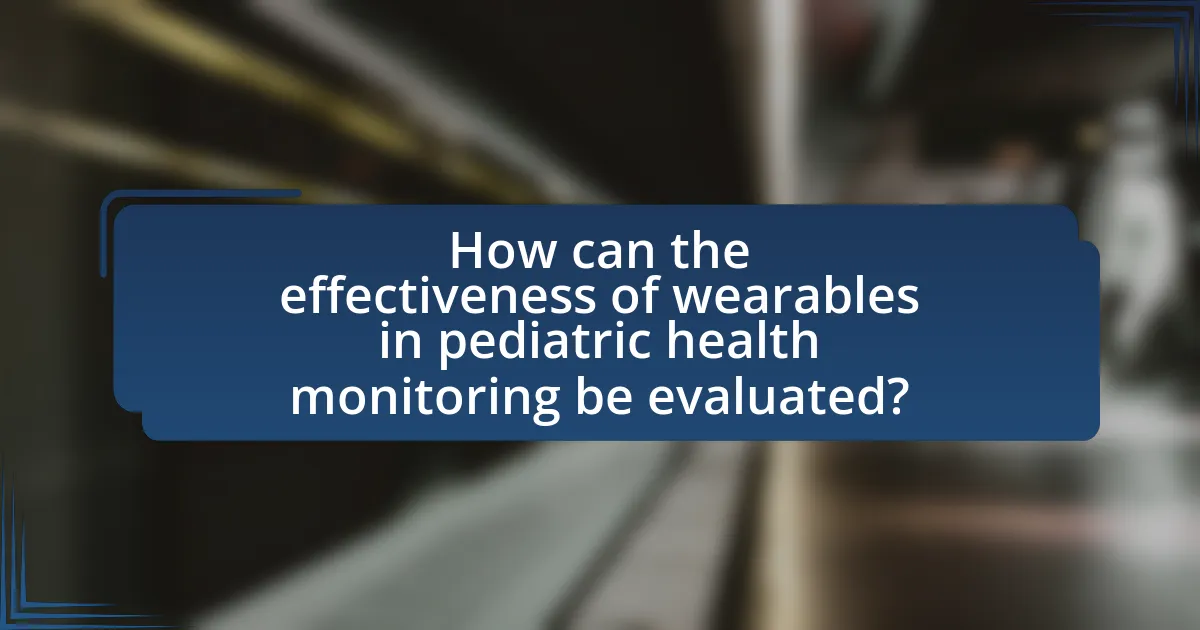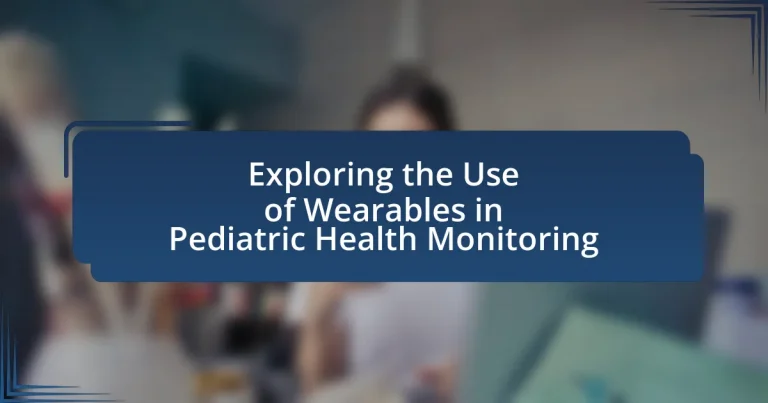Wearables in pediatric health monitoring are electronic devices designed for children to track health metrics such as heart rate, physical activity, and sleep patterns. These devices facilitate continuous health monitoring, enabling timely interventions and personalized healthcare, which can lead to improved health outcomes. The article explores how wearables function, the types of data they collect, their key features tailored for children, and the safety measures integrated into these devices. Additionally, it discusses the benefits of wearables in preventive healthcare, the challenges associated with their use, and best practices for implementation, emphasizing the importance of data privacy and caregiver involvement in maximizing their effectiveness.

What are Wearables in Pediatric Health Monitoring?
Wearables in pediatric health monitoring are electronic devices designed to be worn by children to track various health metrics such as heart rate, physical activity, sleep patterns, and other vital signs. These devices, which include smartwatches, fitness trackers, and specialized medical sensors, enable continuous health monitoring and data collection, facilitating timely interventions and personalized healthcare. Research indicates that wearables can improve health outcomes by promoting physical activity and enabling early detection of health issues, as evidenced by studies showing increased engagement in physical activities among children using these devices.
How do wearables function in monitoring children’s health?
Wearables function in monitoring children’s health by collecting real-time data on various health metrics such as heart rate, physical activity, sleep patterns, and even stress levels. These devices, often equipped with sensors, track movements and physiological signals, allowing parents and healthcare providers to gain insights into a child’s overall well-being. For instance, a study published in the Journal of Medical Internet Research found that wearable devices can effectively monitor physical activity levels in children, promoting healthier lifestyles and early detection of potential health issues.
What types of data do wearables collect from pediatric patients?
Wearables collect various types of data from pediatric patients, including physiological metrics such as heart rate, respiratory rate, temperature, and physical activity levels. These devices often utilize sensors to monitor vital signs continuously, providing real-time insights into a child’s health status. For instance, a study published in the Journal of Medical Internet Research found that wearable devices can accurately track heart rate and activity levels in children, demonstrating their effectiveness in health monitoring. Additionally, wearables may also gather sleep patterns and behavioral data, which can be crucial for assessing overall well-being and identifying potential health issues early.
How is the data from wearables transmitted and analyzed?
Data from wearables is transmitted via wireless communication technologies such as Bluetooth, Wi-Fi, or cellular networks. These technologies enable the wearables to send collected health metrics, like heart rate or activity levels, to paired devices or cloud servers for analysis. Once transmitted, the data is processed using algorithms that can identify patterns, trends, and anomalies, allowing healthcare providers to monitor pediatric health effectively. For instance, a study published in the Journal of Medical Internet Research highlights that real-time data analysis from wearables can lead to timely interventions in pediatric care, demonstrating the effectiveness of this transmission and analysis process.
What are the key features of pediatric wearables?
Pediatric wearables are designed with key features that prioritize health monitoring, safety, and user-friendliness for children. These devices typically include real-time health tracking capabilities, such as heart rate monitoring, activity tracking, and sleep analysis, which provide valuable data for parents and healthcare providers. Additionally, pediatric wearables often incorporate safety features like GPS tracking for location monitoring and emergency alerts to ensure child safety. Many devices are also designed to be durable and water-resistant, accommodating the active lifestyles of children. Furthermore, user-friendly interfaces and engaging designs are essential to encourage children to wear and use the devices consistently.
How do these features cater specifically to children’s needs?
Wearable features cater specifically to children’s needs by providing real-time health monitoring, which is crucial for early detection of potential health issues. These devices often include functionalities such as heart rate tracking, activity monitoring, and sleep analysis, tailored to the unique physiological and developmental characteristics of children. For instance, studies show that continuous heart rate monitoring can help identify abnormal patterns that may indicate underlying health conditions, allowing for timely medical intervention. Additionally, wearables designed for children often incorporate engaging interfaces and gamification elements, which encourage physical activity and healthy habits, aligning with pediatric health recommendations.
What safety measures are integrated into pediatric wearables?
Pediatric wearables integrate several safety measures to ensure the well-being of children. These measures include secure data encryption to protect sensitive health information, real-time location tracking to monitor a child’s whereabouts, and emergency alert systems that notify caregivers in case of distress. Additionally, many devices are designed with child-friendly materials to prevent skin irritation and are subjected to rigorous safety testing to comply with regulatory standards, such as those set by the Consumer Product Safety Commission. These features collectively enhance the safety and reliability of pediatric wearables in health monitoring.
What are the potential benefits of using wearables in pediatric health monitoring?
The potential benefits of using wearables in pediatric health monitoring include enhanced real-time health data collection, improved adherence to treatment plans, and increased engagement in health management. Wearables can continuously track vital signs, physical activity, and sleep patterns, providing healthcare providers with accurate and timely information to make informed decisions. Research indicates that children using wearables are more likely to adhere to prescribed health regimens, as these devices often incorporate gamification elements that motivate them to stay active. Additionally, a study published in the Journal of Medical Internet Research found that wearables can significantly improve communication between parents and healthcare providers, leading to better health outcomes for children.
How can wearables improve health outcomes for children?
Wearables can improve health outcomes for children by providing real-time monitoring of vital signs and physical activity levels. These devices, such as fitness trackers and smartwatches, enable parents and healthcare providers to track children’s health metrics, facilitating early detection of potential health issues. For instance, a study published in the Journal of Medical Internet Research found that wearables can enhance physical activity levels in children by 25%, leading to better cardiovascular health and reduced obesity rates. Additionally, wearables can promote adherence to treatment plans by reminding children to take medications or engage in prescribed physical activities, ultimately contributing to improved overall health outcomes.
What role do wearables play in preventive healthcare for children?
Wearables play a crucial role in preventive healthcare for children by enabling continuous health monitoring and early detection of potential health issues. These devices, such as fitness trackers and smartwatches, collect data on physical activity, heart rate, sleep patterns, and other vital signs, allowing parents and healthcare providers to track a child’s health in real-time. Research indicates that children using wearables are more likely to engage in physical activity, which can reduce the risk of obesity and related health problems. For instance, a study published in the Journal of Medical Internet Research found that children who wore activity trackers increased their physical activity levels by an average of 30%. This data-driven approach not only promotes healthier lifestyles but also facilitates timely interventions, ultimately improving health outcomes in pediatric populations.
How do wearables enhance communication between healthcare providers and families?
Wearables enhance communication between healthcare providers and families by facilitating real-time data sharing and monitoring of a child’s health metrics. These devices collect vital information such as heart rate, activity levels, and sleep patterns, which can be transmitted directly to healthcare providers. This immediate access to health data allows providers to make informed decisions and communicate effectively with families about their child’s condition. For instance, a study published in the Journal of Medical Internet Research found that wearables improved parental engagement and understanding of their child’s health, leading to better adherence to treatment plans.
What platforms are used to share wearable data with healthcare professionals?
Platforms used to share wearable data with healthcare professionals include Apple Health, Google Fit, and specialized telehealth platforms like MyChart and Teladoc. These platforms facilitate the integration of data from wearable devices, allowing healthcare providers to access real-time health metrics such as heart rate, activity levels, and sleep patterns. For instance, Apple Health aggregates data from various wearables and enables sharing with healthcare providers, enhancing patient monitoring and engagement. Similarly, MyChart allows patients to share their wearable data directly with their healthcare team, improving communication and care coordination.
How can families utilize wearable data for better health management?
Families can utilize wearable data for better health management by tracking vital health metrics such as heart rate, sleep patterns, and physical activity levels. This data enables families to monitor their children’s health trends over time, identify potential health issues early, and make informed decisions regarding lifestyle changes or medical consultations. For instance, a study published in the Journal of Medical Internet Research found that wearable devices can significantly improve health outcomes by providing real-time feedback and personalized health insights, which can lead to better adherence to health recommendations. By analyzing this data collectively, families can foster a supportive environment that encourages healthy habits and proactive health management.

What challenges are associated with the use of wearables in pediatric health monitoring?
The challenges associated with the use of wearables in pediatric health monitoring include issues related to device acceptance, data accuracy, privacy concerns, and the need for parental involvement. Pediatric patients may resist wearing devices due to discomfort or lack of understanding of their purpose, which can hinder data collection. Additionally, the accuracy of health data from wearables can vary, potentially leading to misinterpretation of a child’s health status. Privacy concerns arise from the collection and storage of sensitive health information, necessitating robust data protection measures. Furthermore, effective monitoring often requires active participation from parents or guardians, which can be inconsistent. These challenges highlight the complexities of integrating wearable technology into pediatric healthcare effectively.
What are the privacy concerns related to children’s health data?
Privacy concerns related to children’s health data primarily involve unauthorized access, data breaches, and the potential misuse of sensitive information. Children are particularly vulnerable as they may not fully understand the implications of sharing their health data, which can lead to exploitation or discrimination. According to a report by the American Academy of Pediatrics, the lack of robust data protection regulations specifically targeting children’s health information increases the risk of exposure to harmful practices. Additionally, the Children’s Online Privacy Protection Act (COPPA) mandates parental consent for data collection from children under 13, yet enforcement remains challenging, leaving gaps in protection. These factors underscore the critical need for stringent privacy measures in the management of children’s health data.
How is data security ensured in pediatric wearables?
Data security in pediatric wearables is ensured through a combination of encryption, secure data transmission, and compliance with regulations such as the Health Insurance Portability and Accountability Act (HIPAA). Encryption protects sensitive health data by converting it into a secure format that can only be accessed by authorized users. Secure data transmission protocols, such as HTTPS and secure sockets layer (SSL), safeguard data as it moves between the wearable device and cloud storage or healthcare providers. Compliance with HIPAA mandates that pediatric wearables implement stringent privacy and security measures to protect children’s health information, ensuring that data is only shared with consent and is adequately protected against unauthorized access.
What regulations govern the use of wearables in pediatric healthcare?
The regulations governing the use of wearables in pediatric healthcare primarily include the Health Insurance Portability and Accountability Act (HIPAA), the Children’s Online Privacy Protection Act (COPPA), and guidelines from the Food and Drug Administration (FDA). HIPAA ensures the protection of patient health information, while COPPA mandates parental consent for the collection of personal information from children under 13. The FDA regulates medical devices, including wearables, to ensure safety and efficacy, requiring that any wearable intended for medical purposes undergoes a rigorous approval process. These regulations collectively aim to safeguard children’s health data and ensure that wearable technologies are safe for pediatric use.
What are the technological limitations of current pediatric wearables?
Current pediatric wearables face several technological limitations, including issues with accuracy, battery life, and comfort. Accuracy is often compromised due to the small size and varying physiological characteristics of children, which can lead to unreliable data collection. For instance, a study published in the Journal of Medical Internet Research found that many wearables struggle to provide precise heart rate measurements in children compared to adults. Battery life is another significant limitation, as many devices require frequent recharging, which can disrupt continuous monitoring. Additionally, comfort is a critical factor; many wearables are not designed with children’s unique needs in mind, leading to discomfort and reduced compliance. These limitations hinder the effectiveness of pediatric wearables in health monitoring.
How do battery life and durability affect the usability of wearables?
Battery life and durability significantly enhance the usability of wearables by ensuring they remain functional and reliable for extended periods. A longer battery life allows wearables to operate continuously without frequent recharging, which is crucial for monitoring health metrics in pediatric patients who may not be able to communicate their needs effectively. Additionally, durable devices can withstand the physical activities and potential impacts associated with children’s play, reducing the likelihood of damage and ensuring consistent performance. For instance, studies indicate that wearables with a battery life exceeding 24 hours are more effective in continuous health monitoring, as they can capture data over longer periods without interruption.
What advancements are needed to improve pediatric wearables?
Advancements needed to improve pediatric wearables include enhanced accuracy in health monitoring, increased comfort for prolonged use, and better data integration with healthcare systems. Enhanced accuracy can be achieved through advanced sensors that provide real-time, reliable data on vital signs and activity levels, which is crucial for effective health management in children. Increased comfort is essential, as wearables must be lightweight and designed to fit smaller bodies without causing irritation, ensuring that children are willing to wear them consistently. Better data integration involves creating seamless connections between wearable devices and electronic health records, allowing for comprehensive tracking of a child’s health over time. These advancements are supported by research indicating that improved sensor technology and user-centered design significantly enhance the usability and effectiveness of wearable devices in pediatric populations.

How can the effectiveness of wearables in pediatric health monitoring be evaluated?
The effectiveness of wearables in pediatric health monitoring can be evaluated through clinical trials, user feedback, and data analytics. Clinical trials assess the accuracy and reliability of wearable devices in tracking health metrics such as heart rate, sleep patterns, and physical activity among children. User feedback provides insights into the usability and engagement levels of pediatric patients and their caregivers, which is crucial for adherence to health monitoring. Data analytics involves analyzing the collected health data to determine trends and outcomes, such as improvements in health conditions or lifestyle changes resulting from the use of wearables. Studies have shown that wearables can lead to better health management in children, with a report from the Journal of Medical Internet Research indicating that continuous monitoring can significantly improve chronic disease management in pediatric populations.
What metrics are used to assess the impact of wearables on children’s health?
Metrics used to assess the impact of wearables on children’s health include physical activity levels, heart rate variability, sleep patterns, and adherence to health-related goals. These metrics provide quantifiable data that can indicate changes in children’s physical fitness, cardiovascular health, and overall well-being. For instance, studies have shown that wearables can effectively track daily step counts, with a target of 10,000 steps often recommended for children to promote physical activity. Additionally, heart rate monitoring can help identify cardiovascular responses to exercise, while sleep tracking can reveal patterns that affect cognitive and physical development.
How do clinical studies measure the success of wearable technology?
Clinical studies measure the success of wearable technology by evaluating specific health outcomes, user engagement, and data accuracy. These studies often utilize metrics such as adherence rates, physiological changes (e.g., heart rate, activity levels), and patient-reported outcomes to assess effectiveness. For instance, a study published in the Journal of Medical Internet Research demonstrated that wearables improved physical activity levels in pediatric populations by 30% over a six-month period, indicating a positive impact on health behaviors. Additionally, researchers analyze the reliability of data collected by wearables through validation against clinical benchmarks, ensuring that the technology provides accurate and actionable health information.
What feedback mechanisms are in place for users of pediatric wearables?
Pediatric wearables incorporate several feedback mechanisms to enhance user experience and health monitoring. These mechanisms include real-time data alerts, mobile app notifications, and caregiver dashboards that provide insights into the child’s health metrics. For instance, wearables can send immediate alerts to parents or guardians if abnormal heart rates or activity levels are detected, ensuring timely intervention. Additionally, many devices feature user-friendly apps that allow caregivers to track trends over time, facilitating better health management. Research indicates that such feedback systems improve adherence to health protocols and empower caregivers with actionable information, ultimately leading to better health outcomes for children.
What best practices should be followed when implementing wearables in pediatric health monitoring?
Best practices for implementing wearables in pediatric health monitoring include ensuring age-appropriate design, prioritizing data privacy, and involving caregivers in the process. Age-appropriate design is crucial as it enhances usability and engagement; for instance, wearables should be lightweight and visually appealing to children. Prioritizing data privacy is essential to protect sensitive health information, as pediatric data is subject to strict regulations like COPPA (Children’s Online Privacy Protection Act). Involving caregivers ensures that the technology aligns with the child’s health needs and promotes adherence to monitoring protocols. These practices are supported by studies indicating that user-friendly designs and caregiver involvement significantly improve health outcomes in pediatric populations.
How can healthcare providers ensure proper usage of wearables among children?
Healthcare providers can ensure proper usage of wearables among children by implementing comprehensive education and support programs tailored to both children and their guardians. These programs should include clear instructions on how to use the devices effectively, emphasizing the importance of consistent wear for accurate health monitoring. Research indicates that children are more likely to engage with wearables when they understand their purpose and benefits, as highlighted in a study published in the Journal of Medical Internet Research, which found that educational interventions significantly improved adherence rates among pediatric patients. Additionally, healthcare providers should regularly follow up with families to address any challenges and reinforce the importance of the wearables in managing health conditions.
What tips can families follow to maximize the benefits of pediatric wearables?
Families can maximize the benefits of pediatric wearables by ensuring consistent usage, engaging in regular data review, and fostering open communication about health metrics. Consistent usage helps establish reliable data patterns, which are crucial for monitoring health trends. Regularly reviewing the collected data allows families to identify any concerning changes in their child’s health, enabling timely interventions. Additionally, fostering open communication encourages children to express how they feel about their health and the wearables, which can enhance adherence and provide valuable insights into their well-being.



